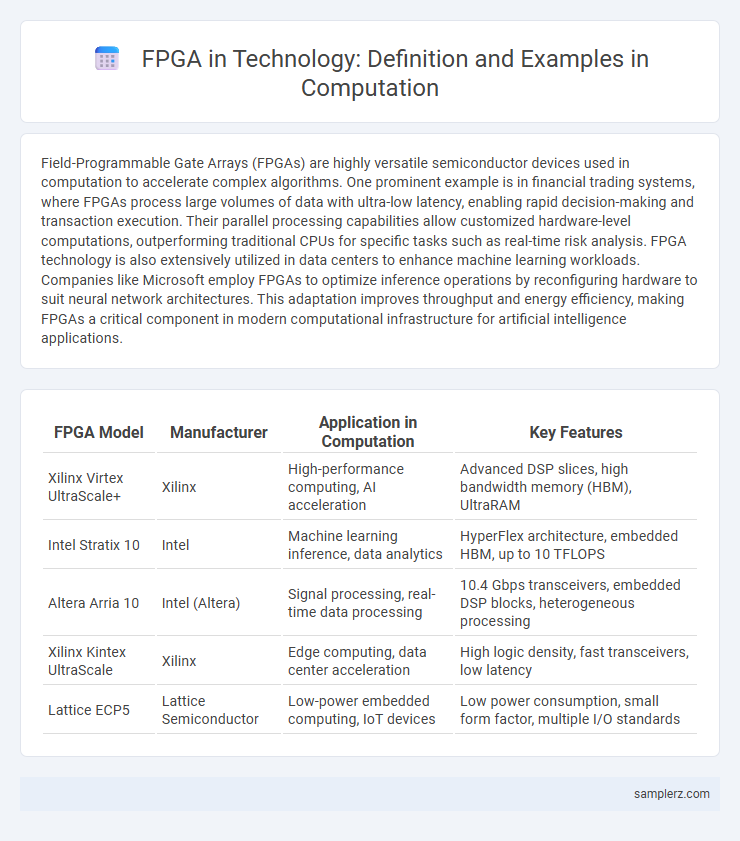Field-Programmable Gate Arrays (FPGAs) are highly versatile semiconductor devices used in computation to accelerate complex algorithms. One prominent example is in financial trading systems, where FPGAs process large volumes of data with ultra-low latency, enabling rapid decision-making and transaction execution. Their parallel processing capabilities allow customized hardware-level computations, outperforming traditional CPUs for specific tasks such as real-time risk analysis. FPGA technology is also extensively utilized in data centers to enhance machine learning workloads. Companies like Microsoft employ FPGAs to optimize inference operations by reconfiguring hardware to suit neural network architectures. This adaptation improves throughput and energy efficiency, making FPGAs a critical component in modern computational infrastructure for artificial intelligence applications.
Table of Comparison
| FPGA Model | Manufacturer | Application in Computation | Key Features |
|---|---|---|---|
| Xilinx Virtex UltraScale+ | Xilinx | High-performance computing, AI acceleration | Advanced DSP slices, high bandwidth memory (HBM), UltraRAM |
| Intel Stratix 10 | Intel | Machine learning inference, data analytics | HyperFlex architecture, embedded HBM, up to 10 TFLOPS |
| Altera Arria 10 | Intel (Altera) | Signal processing, real-time data processing | 10.4 Gbps transceivers, embedded DSP blocks, heterogeneous processing |
| Xilinx Kintex UltraScale | Xilinx | Edge computing, data center acceleration | High logic density, fast transceivers, low latency |
| Lattice ECP5 | Lattice Semiconductor | Low-power embedded computing, IoT devices | Low power consumption, small form factor, multiple I/O standards |
Introduction to FPGA in Computational Applications
Field-Programmable Gate Arrays (FPGAs) enable highly parallel processing and customizable hardware acceleration, making them ideal for computationally intensive tasks such as signal processing, machine learning inference, and cryptographic algorithms. Their reconfigurability allows real-time optimization of data paths and arithmetic operations, significantly improving performance and energy efficiency compared to traditional CPUs and GPUs. Leading technology companies integrate FPGAs to accelerate workloads in data centers, high-performance computing, and embedded systems.
Real-Time Data Processing with FPGA
FPGA technology excels in real-time data processing by enabling parallel execution of complex algorithms directly on hardware, drastically reducing latency compared to traditional CPUs. Applications such as high-frequency trading, autonomous vehicle sensor fusion, and industrial automation benefit from FPGA's ability to handle multiple data streams simultaneously with deterministic timing. This hardware-level acceleration ensures rapid decision-making and enhanced system responsiveness in critical time-sensitive environments.
FPGA Acceleration in Machine Learning Tasks
FPGA acceleration in machine learning tasks significantly enhances computational efficiency by enabling parallel processing tailored to specific algorithms. These adaptable hardware platforms optimize neural network inference and training workloads, reducing latency and power consumption compared to traditional CPUs and GPUs. Deployment of FPGA-based accelerators in data centers and edge devices improves real-time analytics and model responsiveness across various AI applications.
FPGA-Based Cryptography Solutions
FPGA-based cryptography solutions enable secure, high-speed encryption by leveraging the parallel processing capabilities of field-programmable gate arrays, significantly enhancing the performance of cryptographic algorithms like AES and RSA. These reconfigurable devices facilitate real-time adaptability to evolving security protocols, making them ideal for applications in secure communications and blockchain technology. Integration of FPGA accelerators in cryptographic workflows reduces latency and power consumption compared to traditional CPU implementations, ensuring efficient and scalable data protection.
High-Performance Computing Using FPGA
High-performance computing (HPC) leverages FPGAs to accelerate complex algorithms by providing customizable parallel processing architectures tailored to specific computational tasks. FPGAs enable significant improvements in throughput and energy efficiency compared to traditional CPUs and GPUs, especially in applications like scientific simulations, financial modeling, and machine learning inference. Their reconfigurable hardware supports low-latency data processing, making them ideal for workloads requiring real-time computation and high scalability.
Parallel Processing Capabilities of FPGA
Field-Programmable Gate Arrays (FPGAs) excel in parallel processing by enabling simultaneous execution of multiple computational tasks across configurable logic blocks. This architecture dramatically accelerates data-intensive operations such as matrix multiplication, cryptographic algorithms, and signal processing. Leveraging parallelism, FPGAs deliver high throughput and low latency, making them ideal for AI inference, real-time analytics, and high-frequency trading applications.
FPGA in Signal Processing Applications
Field-Programmable Gate Arrays (FPGAs) are extensively utilized in signal processing applications such as digital filtering, image processing, and real-time data compression due to their parallel processing capabilities and low latency. Their reconfigurable architecture enables efficient handling of complex algorithms like Fast Fourier Transforms (FFT) and adaptive filtering, optimizing throughput in communication systems and radar signal analysis. FPGA-based designs significantly outperform traditional processors in executing high-speed signal processing tasks with energy efficiency and flexibility.
Energy-Efficient Computation with FPGA
FPGAs (Field-Programmable Gate Arrays) enable energy-efficient computation by allowing custom hardware architectures that optimize data flow and parallel processing, significantly reducing power consumption compared to general-purpose CPUs. In applications like machine learning inference and real-time signal processing, FPGAs deliver high performance per watt by minimizing redundant operations and leveraging fine-grained hardware customization. Energy efficiency is further enhanced through dynamic voltage and frequency scaling techniques implemented within FPGA frameworks, making them ideal for edge computing and low-power embedded systems.
FPGA Integration in Data Centers
FPGA integration in data centers accelerates complex computations such as machine learning inference and real-time data processing, significantly enhancing throughput and reducing latency. Leading cloud providers like Microsoft Azure and Amazon Web Services deploy FPGA-based solutions to optimize workload performance and energy efficiency. The customizable nature of FPGAs allows seamless adaptation to evolving algorithms, making them ideal for scalable, high-performance data center applications.
Case Studies: FPGA in Scientific Research
FPGA technology accelerates complex computations in scientific research by providing customizable hardware for parallel processing, exemplified in climate modeling where FPGAs enable faster simulations of atmospheric dynamics. In genomics, FPGAs expedite DNA sequencing data analysis through efficient pattern matching algorithms, significantly reducing processing time compared to traditional CPUs. Researchers in high-energy physics utilize FPGAs to process vast datasets from particle detectors in real-time, enhancing the accuracy and speed of experimental results.

example of FPGA in computation Infographic
 samplerz.com
samplerz.com